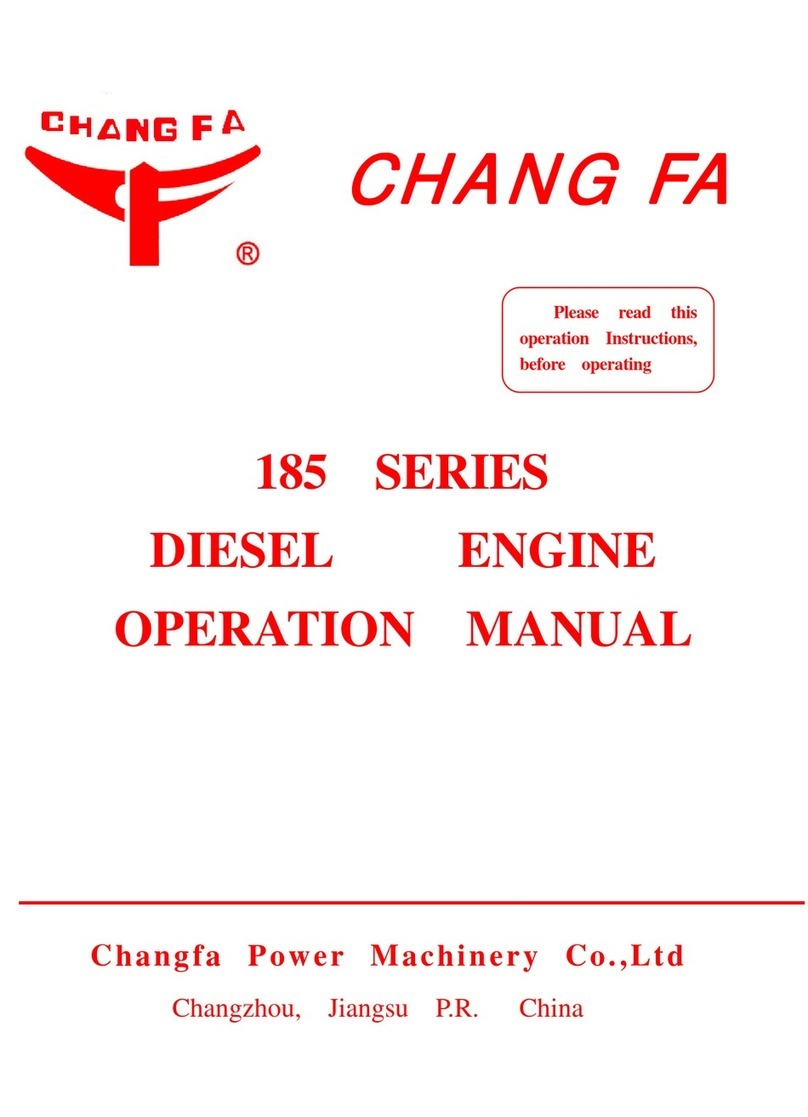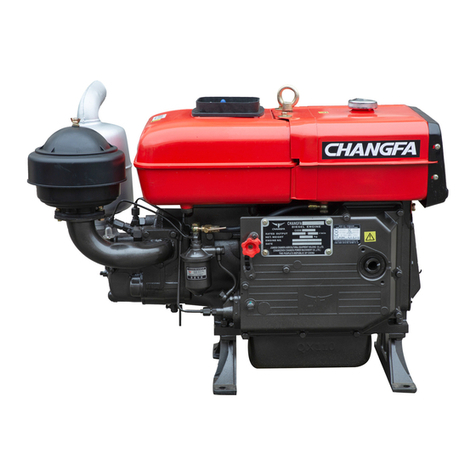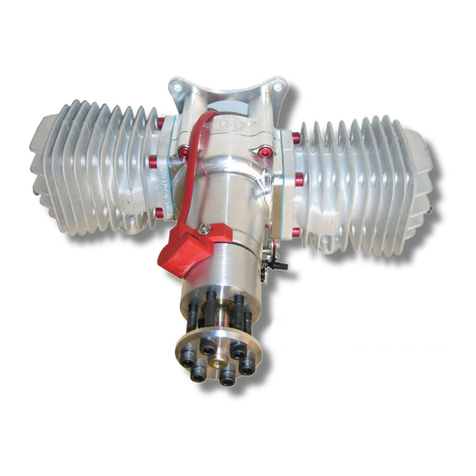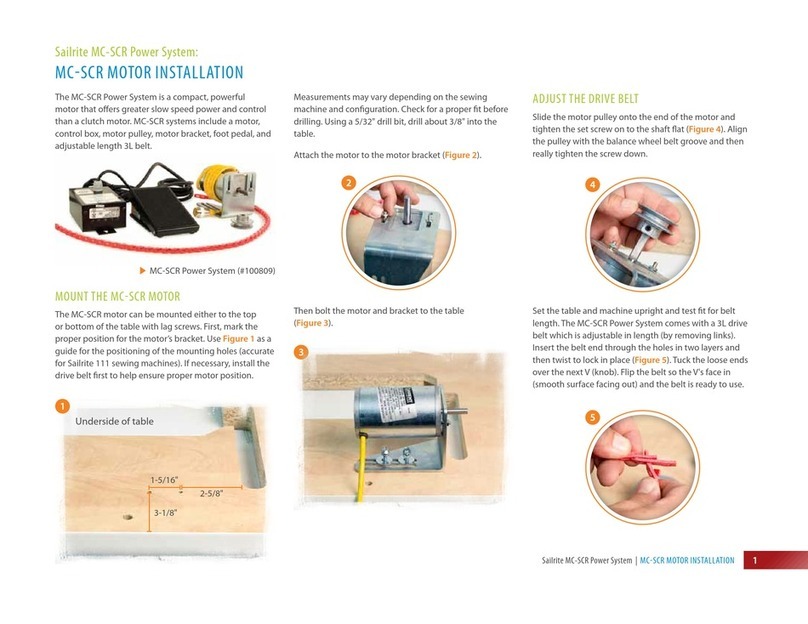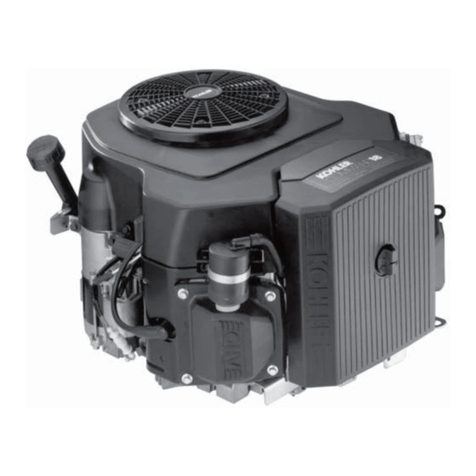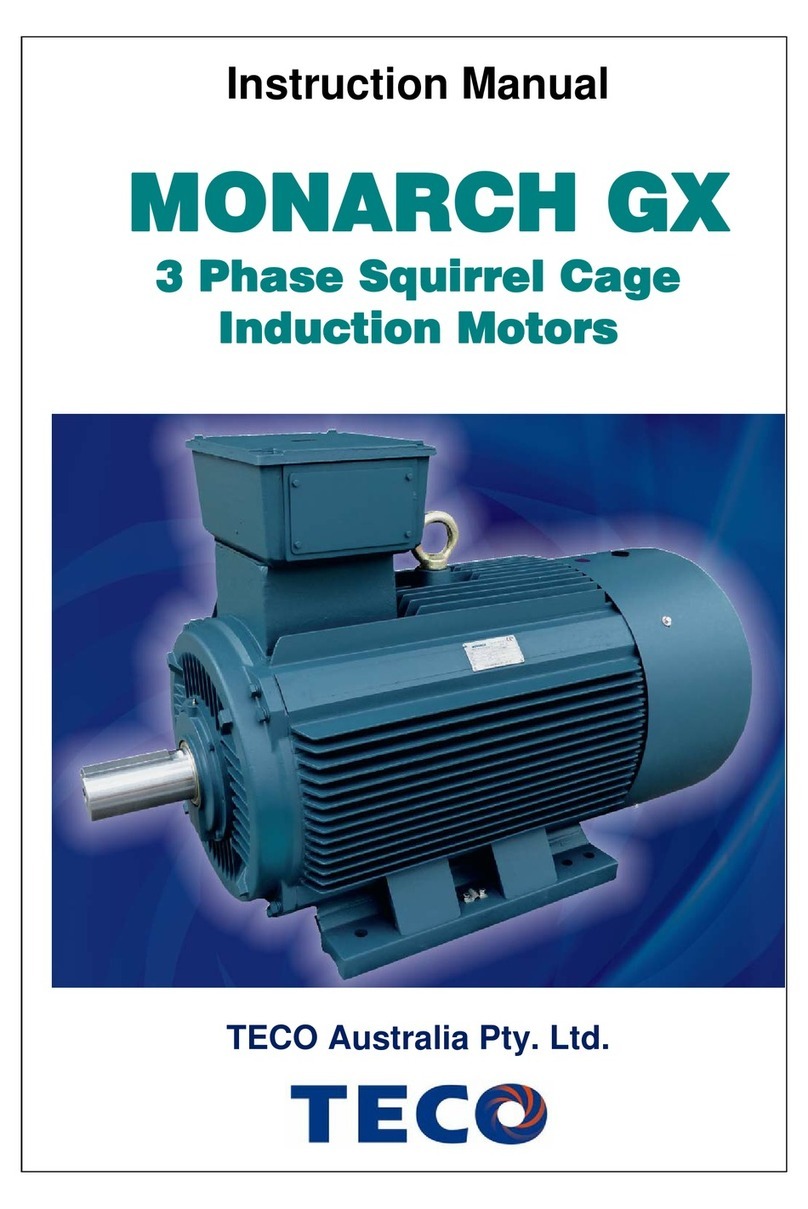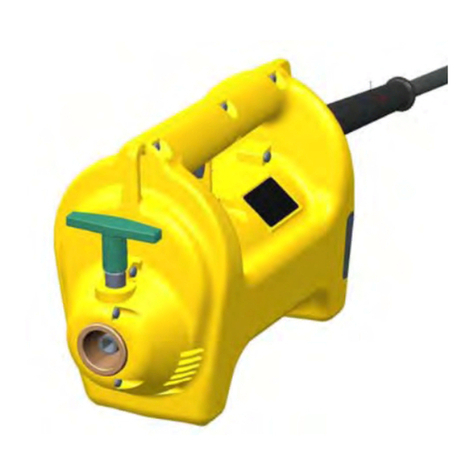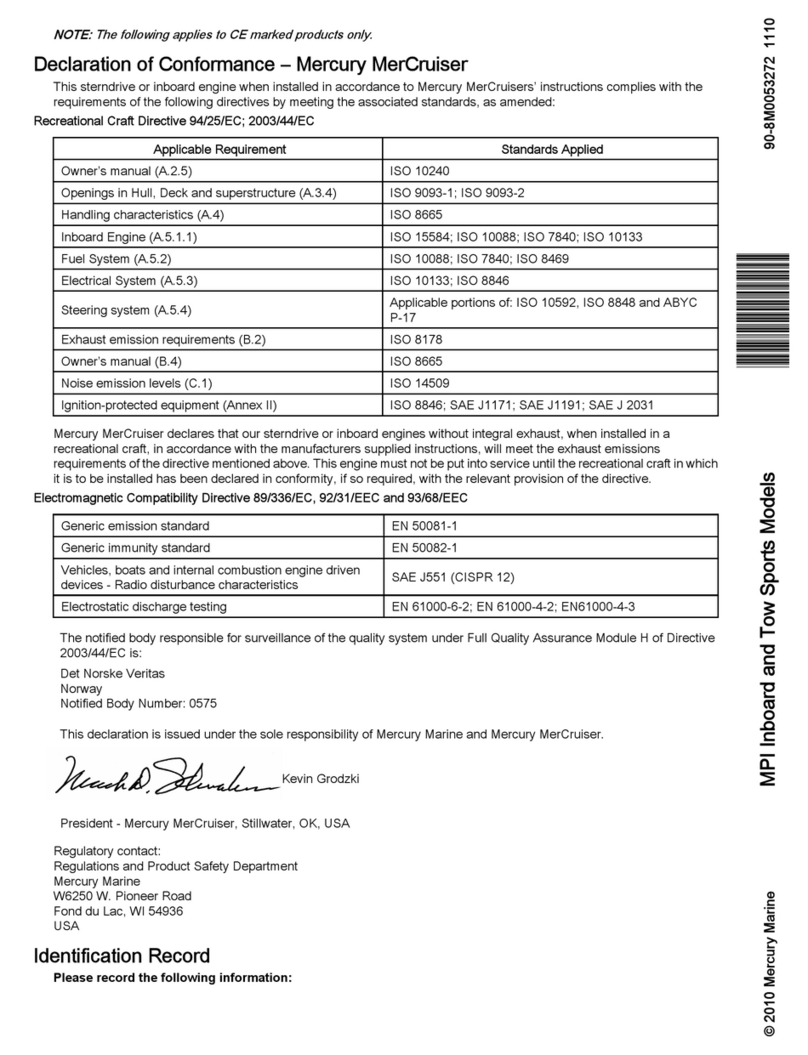Chang Fa S195 Series User manual

Precautions
1. Don’t touch the heating and turning parts.
2. Don’t let those people enter into the operating place, for the children, slow-action
old man, epileptic or the man who has no disposing capacity.
3. Don’t make the engine operate for a long time without operator.
4. As for the performance, please read the performance specification attached for
reference Don’t operate the engine in over-speed and over-load.
5. After starting, allow the engine idle operating in 3~5minutes and it is prohibited to
run the engine in high speed and over-load.
6. Don’t set the adjusting screw of governor system to make the engine operate in
over speed.
7. Don’t shutdown the engine by means of push down decompression lever unless
heavy accident happens
8. Don’t feed the salt-water or dirty water into water tank.
9. Feed and replace the fuel and lubricating oil stipulated in Operation Manual.
10. Feed the lubricating oil in air filter according to the requirement of Operation
Manual.
11. Ensure that the red(blue) floater is not below the hopper of water tank during its
boiling water operation.
12. As soon as engine starts, starting handle leave off automatically. It is necessary to
hold the starting handle to avoid it to fly out.
13. In the climate below 0℃, to prevent the cylinder block and head from breaking,
the cooling water should be drained in good time.
14. Firmly fasten the connections between the engine and the working machine and
take the necessary protecting measure in pulley belt area.
15. If there are some trouble occurring, keep the damaged site in original situation and
settle it after consultation between sales agent and repairman.
16. Run in and maintain the engine according to the requirements of Operation
Manual.
As the diesel engine is now improving constantly, and there maybe some difference
between the manual and the diesel engine, and we will correct it when we revise the manual,
Please forgive us for this matter.
https://truckmanualshub.com/

CONTENTS
Diesel Engine Over all Size and Mounting Size Diagram……………………………1
Section . General Description………………………………………………Ⅰ3
Section . Principal TechnicalⅡSpecifications…………………………………4
Section . Selection of the Size of Pulleys…………Ⅲ……………5
Section .ⅣOperation and Adjustment of the Engine………………………6
1. Preparation…………………………………………………………………6
2. Starting the Engine…………………………………………………………6
3. Stopping the Engine…………………………………………………………7
4. Adjustment of Valve Clearance……………………………………………7
5. Adjustment of Fuel Injection Timing……………………………………8
Section .ⅤTroubles and Remedies……………………………………………9
Section .ⅥDismounting and Reassembly of the Engine………………………12
Section Ⅶ. Fitting Clearances and Wear limits of the Main moving Parts……16
Section Ⅷ.Maintenance of the Engine………………………………………17
SectionⅨ. Preservation and Storage of the Engine……………………………19
PART TWO PARTS LIST WITH ILLUSTRATIONS ……………………20
Fig.ⅠCylinder Block assembly-1…………………………………………………………21
Fig .2 Cylinder Block assembly-2 ……………………………………………………22
Fig .3 Cylinder Head assembly …………………………………………………………23
Fig. 4 Piston and Connecting Rod Assembly …………………………………………25
Fig. 5 Piston and Connecting Rod Assembly …………………………………………26
Fig. 6 Water Hopper Assembly……………………………………………………………27
Fig. 7 Fuel System ……………………………………………………………………28
Fig . 8 Lubrication system ………………………………………………………………30
Fig. 9 Camshaft Assembly ………………………………………………31
Fig10 GearCasing Assembly …………………………………………………32
Fig.11 Intake System …………………………………………35
Fig .12 Exhaust System …………………………………………36
Fig.13 Fuel Injection Pump …………………………………………37
Fig .14 Fuel Injector ……………………………………………………………39
Fig.15:Transmission Assembly (S195NM series )……………………40
Fig.16 :Parts list of radiator cooling system(S195N series)…………41
Fig.17 :Parts list of radiator cooling system(S195N series)…………………………42
Fig.18 Fan assembly (S195N series)………………………………43
Fig.19 Radiator shell Assembly (S195N series)……………………44
Appendix ⅠList of Tools Supplied With the Engine…………………………45
Appendix Ⅱ.List of Spare parts Supplied with the Engine…………………45
Supplementary Instructions for S195M DIESELENGINE……………46
https://truckmanualshub.com/

3
Section Ⅰ. General Description
S195 SERIES Diesel engine is the single cylinder, horizontal,
4-stoke, and water cooling diesel engine. Having the advantages of
light weight, compact construction, easy transport, simple
installation, little vibration, smooth running and easy maintenance, It
is suitable for powering walking tractors and for driving agricultural
irrigation and drainage pumps, as well as other agricultural
processing machines such as threshers, huskers, grinders and forage
pulping machines. It can also be used as a prime mover for small
electrical generators, air compressors, small river ship-propulsion
and motor vehicles.
Normal and reliable operation of this engine depends upon a
correct service and good maintenance which, in turn, will prolong
the life of the engine to the utmost. Therefore, it is recommended
that the operators read the instructions carefully, correctly mastering
the procedure of service and maintenance, in order to make full use
of engine power and give a good service.
Please read this operation Instructions, before operating.
https://truckmanualshub.com/

4
Section Ⅱ. Principal Technical Specifications
Model S195(M) S195N(M) S195B
Type Single-cylinder, four-stroke, Water cooling, horizontal type
Cylinder bore 95mm
Piston stroke 115mm
Piston displacement 0.815L
12-hour power 8.82kW 8.32 kW 9.7kW
1-hour power 9.7kW 9.48 kW 10.8 kW
Rating rotation speed 2000r/min 2200r/min
Compression ratio 20
B.M.E.P.650kPa 613kPa 650kPa
Specific Fuel consumption ≤258.4g/kW·h ≤265.2 g/kW·h ≤259.8g/kW·h
Injection pressure 12.75±0.5 MPa 13.5±0.5 MPa
Cooling method Water-evaporation Water radiator Water-evaporation
Starting method Hand cranking (motor starting)
Net. Weight ≤145kg(155kg)≤150kg(155kg)≤145kg(155kg)
Hand cranking 814×480×618 814×490×713 814×480×618
O
verall dimension
s
motor starting 942×480×680 942×480×713 942×480×680
Intake valve 0.35±0.05mm
Valve clearance (cold engine) Exhaust valve 0.45±0.05mm
Torque of cylinder head nut 270 N·m ~285N·m
Torque of flywheel nut 350N·m~450 N·m
Torque of connecting rod bolts 88 N·m ~110 N·m
Fuel injector type P21-10N
Fuel injector nozzle ZS4S1
Fuel injection pump type P72-4 fuel injection pump
Fuel filter type C0506B
Generator Flywheel AC generator
Air filter According to the requirement of customer
Intake valve open 17º before T.D.C.
Intake valve close 43º after B.D.C.
Exhaust valve open 43º before B.D.C.
V
alve Timing
Exhaust valve
close 17º after T.D.C.
Fuel injection timing 18º±1º before T.D.C.
https://truckmanualshub.com/

Section Ⅲ. Selection of the Size of Pulleys
When the flywheel of diesel engine is connected with working machine, the
selection of the size of pulleys, directly affects the operation conditions of the engine and
the productivity of the driven machine. The size of pulleys may be calculated according to
the following formulas:
D1×n1
D2= n
2
Where:
D1is the diameter of the engine pulley (The diameter of V-belt used for pulley is
calculated by the pitch diameter, mm);
D2is the diameter of the pulley on the shaft of the driven machine(The diameter of
V-belt used for pulley is calculated by the pitch diameter, mm);
n1is the rotation speed of the engine;
n2is the rotation speed of the driven machine.
One V-belt pulley with pitch diameter of 125mm is attached to the engine on its
delivery from the factory (If the pulleys of special size are required, it can be ordered
through negotiation.).
5
https://truckmanualshub.com/

Section Ⅳ. Operation andAdjustment o f the Engine
(1)、Preparation
1. Lubricating oil
Use lubricating oil #CC15W/40 in summer, #CC15W/30 in winter.
Caution: The oil level must not go over the upper line on the dipstick, nor fall
down below the lower one, when the engine is in operation.
2. Diesel fuel
Use light diesel fuel #0 in summer, #-10 or # -20 in winter.
⑴Loosen the vent screw on the fuel infection pump or loosen the fuel pipe
connection. When it is noted that fuel without air bubbles flows out, retighten the vent
screw or connections.
⑵Set the speed —control lever knob at the “start” position indicated on the panel.
Screw off the plug on the gear casing , insert the fuel priming handle through the hole
and move it to and fro until a“chattering”action of the fuel injector is noted.
Caution: Pour clean diesel fuel into the fuel tank. Do not get into any dust.
3. Cooling water
Pour clean water into the hopper, until the red ball of the float stem rises up to the
highest position. Do not use dirty water or water which contains alkaline or salt.
(2)、Starting the Engine
Set the speed —control lever
knob at the “start” position indicated
on the panel.
Push down the decompression
lever towards the right with your
left hand and hold it, Crank the
engine clockwise with your right
hand by means of the staring handle
and gradually speed up. When the
cranking speed attains its maximum,
suddenly release the decompression lever,
6
https://truckmanualshub.com/

7
but continue to crank the engine with effort. Then the engine will start running itself.
After starting, check again the red float in the oil indicator and see if it rises up, and
allow the engine to run for 3~5 minutes at low speed without any load just after its being
started, then increase the speed gradually and load the engine.
Caution:
Once the engine starts up running, the starting handle, because of the action of the
spiral – jaws on its clutching end, will disengage and jerk out of itself, and therefore the
operator must keep on holding it firmly in order to prevent any incident.
★Running at high speed with full load after its being started is strictly
forbidden.
(3)、Stopping the Engine
Gradually unload the engine and let it run idle for a while. Move the speed —
control lever knob to the “stop” position, the engine will then stop running.
If the engine is to be put out of service for a long period of time,
1. Drain out the cooling water completely.
2. Turn the engine until fail to turn it, then push down the decompression lever
and continue to turn the flywheel the mark —line T.D.C on the periphery of
the flywheel coincides with the mark —line on the hopper.
3. Close the fuel cock.
4. Examine the oil in the air filter. If it becomes either dirty or diluted, it should be
changed with clean oil, after both the filter cartridge and the filter body have
been cleaned and wiped. The quantity of oil is such that its level is just up to the
marked line inside the body.
5. Adjust the valve clearance to the specified value ( Intake valve clearance —
0.35±0.05mm, exhaust valve clearance —0.45±0.05mm).
(4)、Adjustment of Valve Clearance
1. Turn the Flywheel until the mark T.D.C. on its periphery coincides with the line
marked on the hopper, in order to set the piston at its top dead center position in
compression stroke.
2. Remove the cylinder head cover.
3. Loosen the locking nut and the adjusting screw on the rocker arm, set the valve
https://truckmanualshub.com/

8
clearance to the specified value by means of a feeler gauge inserted between the
valve stem and the rocker arm. (Intake valve clearance is 0.35 mm. And exhaust
valve clearance 0.45mm).
4. In the course of adjusting screw —in the adjusting screw to such an extent that
push rod is just free to turn but not too loose. When this is done, tighten the
locking nut in order to prevent any loosening afterwards.
5. Remove the feeler gauge and check the clearance once again.
6. Install the cylinder head cover to ensure normal operation of the decompression
handle.
(5)、Adjustment of Fuel Injection Timing
Disconnect the high-pressure fuel pipe from the injector. Loosen the nut which
connects the high pressure fuel pipe to the injection pump, turn the pipe around so that the
open end of the pipe is upwards, and retighten the nut. Turning the flywheel slowly, Until
the fuel just begins to flow out of the open end of the pipe. Stop turning and check
whether the mark —line on the periphery of the flywheel coincides with the mark line
on to hopper, In case the injection timing is too advanced or too lagging behind,
adjustment is then necessary. Increase or decrease the number of shims between the pump
flange and mounting surface of gear casing. Increase the number of shims if injection
timing is advanced, decrease the number of shims if lagging.
Caution : The ball of the plunger adjusting arm must be engaged with the slot in
the speed —governing fork inside the gearcasing.
https://truckmanualshub.com/

9
Section Ⅴ. Defects and Elimination
A. Engine Fails to Start
Cause Remedy
1. Unsteady fuel flow
Check the fuel tank and the element of the fuel filter
whether there is any water or dirt. Clean the element in clean fuel
if it is chocked with dirt, or clean the fuel tank and fill it with
clean fuel of recommended grade if any water is found in the
tank.
2. Air in the fuel pipe line Release air and then tighten all fuel pipe connections.
3. Fuel injection timing
incorrect Adjust according to the recommended procedure.
4. Valve clearance incorrect Adjust according to the recommended procedure.
5. In cold weather, lubricating
oil becomes too viscous,
difficult to crank the engine
Pour hot water into the hopper, or preheat the lubricating oil
before pouring it into the oil sump, but do not heat the oil sump
with external fire. It is also advisable to disconnect the engine
from the driven machine by pulling off the belt, then start the
engine. Stop it after the engine has been warmed up, reput the
belt on and start the engine again.
6. Insufficient compression in
the cylinder
The wearing - out of intake and exhaust valves, as well as of
piston, piston rings and cylinder liner is the main factor to give
rise to in sufficient compression. Pouring about 25 grams of
lubricating oil into the intake manifold will be of some assistance
to increasing the compression pressure in the cylinder. If leakage
at the cylinder head gasket occurs, it is then necessary to tighten
the cylinder head nuts. Any worn gasket should be replaced
7. Pumping element (plunger
and barrel) of the injection
pump or injector nozzle worn
-out
Replace with new one.
https://truckmanualshub.com/

10
B. Engine Does Not Develop Full Power
Cause Remedy
1.Insufficient compression in the
cylinder
Proceed as item 6 under “Engine Fails to Start.” If parts
are worn, in excess of the specified wear limit, then
replacement should be made.
2. Fuel injection timing incorrect Adjust according to the recommended procedure.
3. Valve clearance incorrect Adjust according to the recommended procedure.
4. Air filter choked Clean it in clean fuel or kerosene.
5. Engine speed too low or too
high
Adjust the speed —control lever knob to make the
speed attain its rated value.
6. Pumping element (plunger
and barrel)of the injection pump
or injector nozzle worn-out or
opening pressure of the injector
incorrect
Replace them, or adjust the opening pressure of the
injector to 12.75MPa ±0.5MPa or13.5MPa ±0.5MPa
(S195B).
C. Engine Stalls
Cause Remedy
1. Flow of fuel interrupted
Supply with sufficient quantity of
fuel to the fuel tank. If there is air in the fuel
pipe line or the fuel filter is choked, vent and
remove all air and dirt.
2. Quantity of lubricating oil insufficient, or
some parts burnt due to faults in lubrication
system
Examine the quantity of oil by means of
the dipstick, replenish if insufficient. Inspect
the oil pump to see if it woks normally and
check all oil ducts. Find out the troubles and
remedy them. Replace the burnt part with
new one if any exists.
3. Sticking of the needle valve with the
nozzle body of the injector
If no “chattering” is heard from the
injector while turning the starting shaft of the
engine, it will often indicate that the needle
valve is stuck or seized. In that case, clean it
in clean fuel and lap it a little with the nozzle
body. Replace it if necessary
4.When the load increased, speed system blocked Find out the reason of block and remedy them
5. Valve spring or injection pump spring broken Replace a new one
https://truckmanualshub.com/

11
D. Engine Exhausts Dense Black Smoke
Cause Remedy
1. Engine overloaded
Reduce the load appropriately. If the
belting or coupling with the driven machine
is not right, correct it.
2. Faulty injector
Check the opening pressure of the
injector and the atomization of the fuel spray.
Correct it if necessary, or replace it if worn
3. Incomplete combustion
This results mainly from faulty injector,
incorrect fuel injection timing, leakage
through the cylinder head gasket and from
insufficient compression, etc. Remedy
whatever the real cause may be.
4. Connecting rod bearing shells burnt, or
sticking of the bearing shells with crankshaft
Replace the connecting bearing
shells ,or repair the crankshaft.
E. Other Defects
(If any of the following conditions arises, it is necessary to stop the engine immediately)
Cause Remedy
1. Engine speed “hunting”
Check the sensitivity of the governor
system, and vent the fuel supply line if there
is any air in it.
2. Abnormal engine noise suddenly arises Make a careful check for every moving
part.
3. Engine suddenly exhausts black smoke Proceed according to the part “D”.
4. Red float in the oil indicator suddenly
drops down
Examine the lubrication system to see if
the oil strainer screen and other oil duct are
choked and to observe whether the oil pump
operates normally.
https://truckmanualshub.com/

12
Section Ⅵ. Dismounting and Reassembly of the Engine
If it is necessary to dismount the engine for maintenance and repair, it is recommended
to proceed in the following order:
A. Draining out the cooling water by opening the drain cock.
B. Removing the cylinder head cover and the cylinder head.
1. Turn off the pipe connection bolt from the inlet of the oil indicator and the
Fixing-nuts on the cylinder head cover. Then the cylinder head cover may be remover.
2. Close the fuel cock under the fuel tank, and then disconnect the fuel —leak
—off connecting pipe of the injector from the fuel filter.
3. Screw off the bolts which connect the air filter with the intake pipe. And
remove the air filter and intake pipe.
4. Screw off the two bolts which connect the exhaust silencer with the cylinder
head and remove the silencer as a whole .
5. Turn off the two nuts which hold down the rocker —arm shaft support on the
cylinder head, remove the support and draw out the two valve push rods.
6. Remove the high pressure fuel pipe.
While reinstalling the high pressure fuel pipe, it is necessary to turn but not to
tighten the connecting nuts on both ends of the pipe simultaneously, and first tighten the one
which connects the pipe with the injection pump. Operate the pump with the fuel priming
handle until fuel flows out of the other end of the pipe which is connected with the injector.
Then tighten the nut on this end.
7. Screw off the nuts holding down the injector clamping plate, then remove the
injector and the clamping plate.
While reinstalling the injector, the sealing copper washer should be slipped on the
nozzle before it is put back into its place. The two nuts are to be tightened evenly.
8. Turn off the cylinder head nuts, and remove the cylinder head. While
reinstalling, the cylinder head nuts are to be tightened one by one in a diagonal order and
with a final torque of about 270 N•m ~285N•m.
9. Remove the fuel cylinder head gasket. Pay attention to the right-side and
back - side of it when remounting.
C. Removing the fuel tank and the hopper
1. Close the fuel cock in the fuel supply pipe.
2. Remove the lifting eye nut.
3. Disconnect the fuel supply pipe from the fuel filter.
4. Screw off two bolts located above the rear cover of the cylinder block, which
fix the fuel tank on the block, and also screw off the two bolts connecting the fuel tank and
the hopper together .Then remove the fuel tank.
https://truckmanualshub.com/

5. Remove the funnel assembly from the hopper.
6. Screw off the four bolts inside the hopper, which fix the hopper on the cylinder
block. Then take off the hopper and remove the hopper gasket.
7. Remove the upper cover of the cylinder block and its gasket.
D. Dismounting the gear casing
1. Screw off the bolts which fix the gear
casing to the cylinder block, and take off the
gear casing .
2. Draw out the camshaft along with its gear, and
take of the starting gear along with its shaft.
3. Dismantle the speed -governor gear,
sliding ball -race and steel balls.
Whileassembling,itisabsolutelynecessarythat
the tooth —mesh —marks on all the gears must be respectively
lined up with one another as they were
Fig. 1 Arrangement of gear train
(tooth- mesh- makes must be lined up)
and dismantling of balancing shaft gear
by means of a puller
1
.
Fixin
g
bo
lt 2
.
P
u
ll
er
beforedismantling(Fig1).
E. Removing the rear cover of the cylinder block.
1. Take out the oil dipstick.
2. Screw off the bolts which fit the rear cover on the cylinder block, then remove the
rear cover and its packing.
F. Dismantling and reinstalling the piston -connecting rod assembly
1. Turn the flywheel until the big end of the connecting rod is in the position nearest
to the rear opening of the cylinder block, in order to facilitate the removing of the connecting rod bolts.
2. Cut off by means of a pear of pliers the steel wire which locks connecting rod bolt
and remove it. While re-installing, new wires should be used and twisted tightly.
3. Unscrew the connecting rod bolts by means of the special wrench supplied with the engine.
4. Take off the connecting rod cap.
Caution: The connecting rod bearing shells must be well protected while taking off the cap.
5.Turn the flywheel slowly until the piston is at the top dead center position (Any carbon
deposit on the wall of the cylinder liner should be pre-moved). Then push slowly the piston —
13
https://truckmanualshub.com/

connecting rod assembly out of the cylinder bore by means of a wooden rod against the big end of
the connecting rod through the rear opening of the cylinder block.
Caution: Becarefulofthisoperationnottodamagethecrankpin,thecylinderlinerandthepiston
While reinstalling, the 45°parting surface of the big end of the connecting rod must be kept
downwards, the cap must be fitted on in such a way that the matching marks on both the cap and
the rod should be on the same side. The piston rings are to be so fitted on to the piston that the gaps
are spaced 120ºapart from one another . and the ends of the second and third compression rings on
which there is a mark“T”are kept upwards (to wards the cylinder head).The connecting rod bolts
are tightened with a torque of about 88 N•m ~110N•m. but before being completely tightened, it is
necessary to turn the flywheel to see if the moving parts move freely , and then tighten the bolts
evenly and completely. Further more, while re-installing, the crankpin, the connecting rod bearing
shells, the piston and the piston rings are all to be smeared with a little clean lubricating oil. If it is
necessary to replace the small end bushing of the connecting rod, then after replacement, the
connecting rod should be so assembled back with the piston as it was before.
G. Dismantling the flywheel
1. Remove the pulley.
2. Unlock the lock washer of the flywheel nut.
3. Loosen the flywheel nut by means of a special wrench (knock the handle of the wrench
with a hammer counter —clockwise, if necessary.), but do not screw it off (Fig. 2)
Fig. 2 Loosening the flywheel nut by
knocking the handle of the wrench with
a hammer.
14
Fig. 3 Removing the flywheel be means
of the
p
ulle
r
4. Pull -out the flywheel by means of the puller. A hammer may be used to knock
the center of the bridge of the puller if the flywheel is difficult to pull out (Fig. 3 , Fig. 4).
5. Screw off the flywheel nut and take off the flywheel. Be careful not to damage the
thread on the end of the crankshaft while taking off the flywheel, and do it with safety since the
flywheel is heavy.
https://truckmanualshub.com/

15
6. Remove the flat key from the crankshaft by
means of a M6 cap screw.
H. Removing and reassembling the crankshaft
1. Take off the oil pipe. which connects the
main bearing housing with the oil indicator by
screwing off the pipe connection form the housing..
2. Remove all the fixing blots of the main bearing
housing.
3.Pull out the main bearing by screwing the two
M8 bolts simultaneously and slowly into the two holes
which are diagonally spaced on the housing until it is
pulled out. During this operation, be careful to keep the crankshaft form moving out .Put it back if
it does. Other wise, the crankshaft may drop down and get damaged.
Fig. 4 Knocking the center of the
bridge of the puller by means of a
hammer.
A wooden hammer may be used to knock the timing gear side of the crankshaft and carefully
take the crankshaft out of the cylinder block.
4. Carefully take the crankshaft out of the cylinder block.
Caution: during this operation, all the journals of the crankshaft should be protected
from being scratched or damaged. While reassembling, they must be smeared with a layer of
clean lubricating oil.
I. Removing and reassembling the balancing shafts
Under ordinary conditions, it is not recommended to remove the balancing shafts. But if the
ball bearing are worn and need to be replaced, they may be removed and reassembled according to
the following procedure:
1. Take off the bearing cover of the upper balancing shaft on the flywheel side of the
engine, and remove the lubricating oil pump from the lower balancing shaft on the same side.
2. Screw off the bolts on the gear end of both the balancing shafts and remove the gears
by means of the puller.
3. Remove the circlips from the block.
4. Tap both the balance shafts from the flywheel side of the engine by means of a wooden
hammer or a copper rod, until the ball bearings on the other end of the shafts come out of the
cylinder block, and then remove the ball bearing.
5.Similarly, push the balancing shafts towards the flywheel side and remove the ball
bearings on this end of the shafts.
6.After removing the ball bearing, carefully take out the balancing shafts from the
cylinder block.
https://truckmanualshub.com/

16
Section Ⅶ. Fitting Clearances and Wear limits of
the Main moving Parts
No Fitting parts Kind of fitting
Standard
Clearance
mm
Limits of
wear
mm
1 Main journal of crankshaft with main
bearing Clearance 0.08~0.12 0.25
2 Crankpin of crankshaft with connecting
rod bearing Clearance 0.06~0.1.08 0.25
3 Piston pin with connecting rod small
end bushing Clearance 0.020~0.056 0.12
4 Piston skirt with cylinder liner Clearance 0.16~0.225 0.42
5 Open gap of the first piston compression
ring 0.30~0.50 2
6 Open gap of the second piston
compression ring 0.25~0.45 2
7 Open gap of oil scraper ring 0.25~0.40 2
8 Valve stem with guide bushing Clearance 0.05~0.10 0.30
9 Rocker arm shaft with its bushing Clearance 0.016~0.052 0.20
10 Camshaft with its front bushing Clearance 0.035~0.089 0.25
11 Camshaft with its rear bushing Clearance 0.03~0.093 0.25
12 Speed-governing gear shaft with its
bushing Clearance 0.02~0.066 0.25
13 Starting shaft with its bushing(A)Clearance 0.04~0.088 0.25
14 Starting shaft with its bushing(B)Clearance 0.04~0.12 0.25
15 Axial clearance of crankshaft Clearance 0.15~0.28 adjust with
shims
https://truckmanualshub.com/
This manual suits for next models
4
Table of contents
Other Chang Fa Engine manuals
Popular Engine manuals by other brands

O.S. engine
O.S. engine MAX-55HZ HYPER Owner's instruction manual

Briggs & Stratton
Briggs & Stratton 83100 Operator's manual
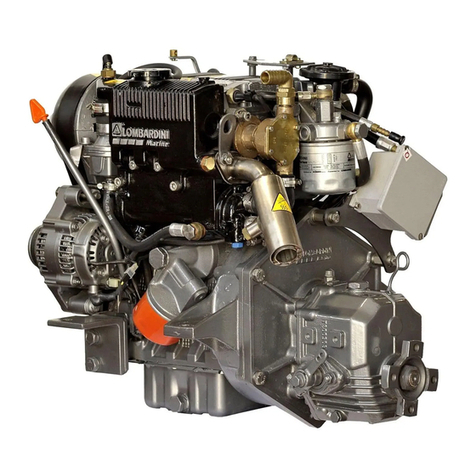
Lombardini
Lombardini LDW 502 Use maintenance and consumer information
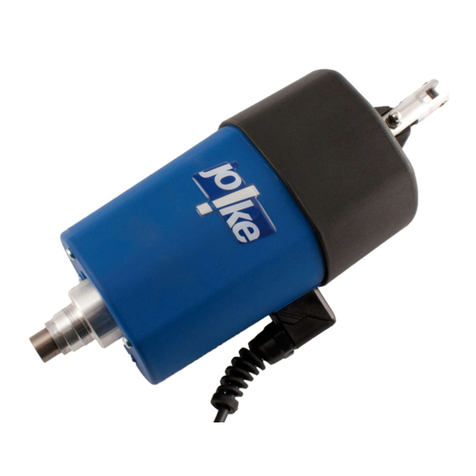
joke
joke jokeFlex Premium Plus instruction manual

E-FLITE
E-FLITE Power 25 instructions
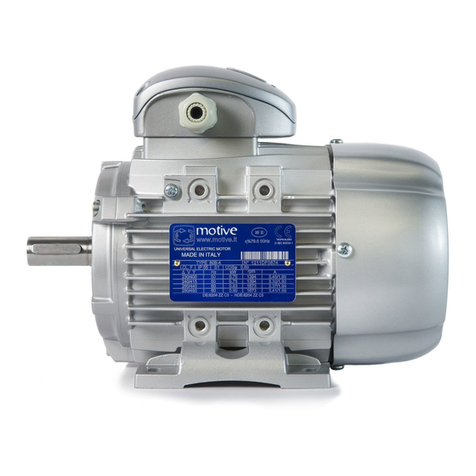
Motive
Motive DELPHI AT Ex Series manual




